Castor-aralia (Kalopanax septemlobus) is a deciduous tree native to Eastern Asia (China, Japan and Korea). Its common names include Tree Aralia and Prickly Castor Oil Tree. It can have thorns up to a half inch long and a trunk five feet in diameter.
It may look tropical but it’s actually cold hardy to about -40ºF. It’s recently been found growing wild in several places in Connecticut. GoBotany (gobotany.nativeplanttrust.org) says it’s been spotted in Massachusetts and New Hampshire.
University of New Hampshire scientists have traced the spread of this exotic tree in local forests to a single tree planted on campus in the early 1970s.
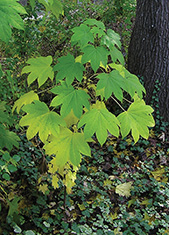
According to the UNH Today website (unh.edu/unhtoday/2015/07/ aliens-woods), “They found it is capable of spreading via seed from planted trees to urban and natural forests in southeastern New Hampshire. The large, deciduous tree, which has been planted as an ornamental tree and can grow to be 100 feet tall, is capable of invading forests of eastern white pine and sugar maple-beech-red oak, common types in New England.”
Harvard University’s Arnold Arboretum reportedly distributed the plant to universities across the country in 1972 as part of its centennial celebration.
It’s typically found on the edges of forests or in man-made disturbed areas. We think it’s a prime candidate for EDRR (Early Detection Rapid Removal). While it’s not officially listed as invasive in any state, we recommend that people remove it if they find it on their property. The entire plant, including roots, should be removed. Because of its ability to resprout cutting is not advised. We couldn’t find any information on what herbicides might be effective.
“Because a single Castor-Aralia individual is capable of a great amount of seed production, even small populations and isolated individuals should be eradicated. The large potential dispersal distance and success of seedlings in human-influenced habitats means that even isolated plants in urban environments, including those at urban arboretums, should be removed,” says Thomas Lee, an Associate Professor Emeritus of Forest Ecology at UNH and lead author of the study, “Incipient Invasion of Urban and Forest Habitats in New Hampshire, USA, by the Nonnative Tree, Kalopanax septemlobus,” published in the journal Invasive Plant Science and Management in 2014.
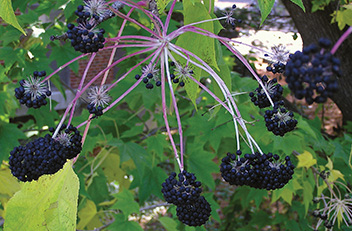
Fruit (drupes) on a mature Castor-Aralia on the UNH campus.
From that study …“The large population size, shade tolerance, rapid height growth, and ability to sprout from damaged stems suggest potential for K. septemlobus to invade and persist in forests, the most common natural ecosystem in the northeastern United States. We further suggest that small propagule size, likely a single tree, has not prevented K. septemlobus from initiating a spatially extensive and vigorous population. Kalopanax septemlobus has been planted as an ornamental in the northeastern United States, and prevention of region-wide invasion might depend on removal of these trees, even when they occur as single individuals.”
Thorns
The trunk, branches and especially younger stems can be protected with thorns up to a half-inch long. The thorns usually disappear from the trunk and older branches as the tree matures.
Leaves
The leaves are arranged alternately and resemble the leaves of the castor bean and sweetgum (Liquidamber styraciflua). They can be more than a foot across and are palmately lobed with 5 or 7 lobes. The leaves, which have finely toothed margins, turn yellow or red in fall but are not particularly attractive.
According to Prof. Lee, the leaves on young plants and on the lower stems of older plants have five shallow lobes. Leaves from the middle branches of older plants are larger, with seven prominent lobes. Often, especially in plants growing in shade, leaves on the upper stem have only five lobes. It can cast deep shade that stunts the growth of native undergrowth.
Flowers & Fruit
Tiny white flowers are held in large umbels up to a foot-and-a-half-across in late summer. Each flower has 4-5 small white petals.
The fruit is a small black drupe with two seeds.
Invasive?
The tree has been found growing wild in New England and elsewhere. It is viewed with concern by the US National Park Service and the Maryland Department of Natural Resources.
Invasive.org lists it as a ‘Plant to Watch,’ saying “Patches are currently limited in size but because it is able to spread vegetatively and by seed; it is a plant to watch and if possible should be removed to prevent its spread.”
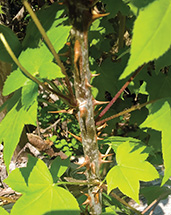
In our opinion the Connecticut Invasive Plant Council should designate this plant as invasive in Connecticut or at least classify it as a candidate for EDRR.
While they’re at it they should ban Japanese barberry. It’s on the list but has not yet been banned in Connecticut as it has in most of the Northeast.
– Will Rowlands
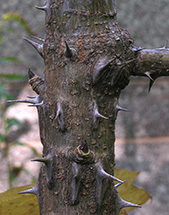


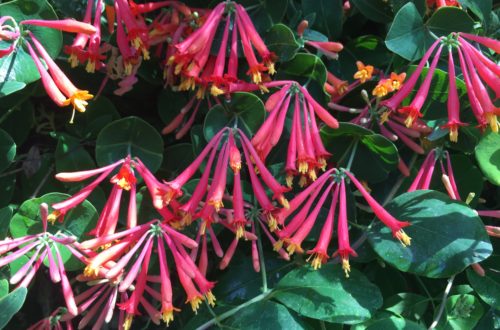
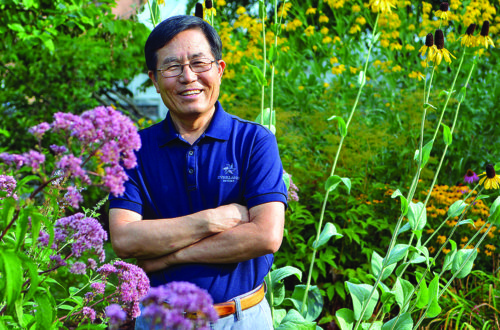

4 Comments
Kyle Dougherty
I’ve been tracking this plant in CT for the last few years. They were rarely planted as ornamentals in the past, and now anywhere that there is a mature specimen there are countless seedlings, up to 2 miles away. Birds love the berries and spread them in their droppings. East Rock Park in New Haven is overrun with them due to two large specimens in a backyard on the western side of the park, and Fulton Park in Waterbury has a crazy number of seedlings at well due to a mature planting of these trees along the western side of the park and over the gazebo. Seedlings in these two parks are likely over 20 years old at this point. There are other mature trees in Woodbridge, Hamden, Mansfield (UCONN Campus) and Walnut Hill Park in New Britain. These plants are obviously invasive, but could be easily controlled by just removing mature specimens, since they need full sun and many years to begin fruiting. Boston is absolutely overrun with these as the Arnold Arboretum has 3 mature specimens that they refuse to remove. I think it would be silly to add these to the invasive plant list before Aralia elata, the Japanese angelica tree, because that plant has already spread much further and fruits much younger and in shadier areas.
Will Rowlands
Thanks Kyle … we’ll look into Aralia elata. Might be our next invasive highlight
Kyle Dougherty
To add to my previous comment, you can see the hotspots for this species on the iNaturalist map here: https://www.inaturalist.org/observations?place_id=49&subview=map&taxon_id=164342&verifiable=any I have successfully located the “parent” trees for the populations in Woodbridge, Waterbury, Mansfield, Hamden, and New Haven, but was unable to find the parent tree in Old Lyme (may be in someone’s backyard near the Florence Griswold Museum), Preston, and Thompson.
Will Rowlands
Kyle,
If you have any photos of Aralia elata in Connecticut we may be able to use them in a story.
Will Rowlands